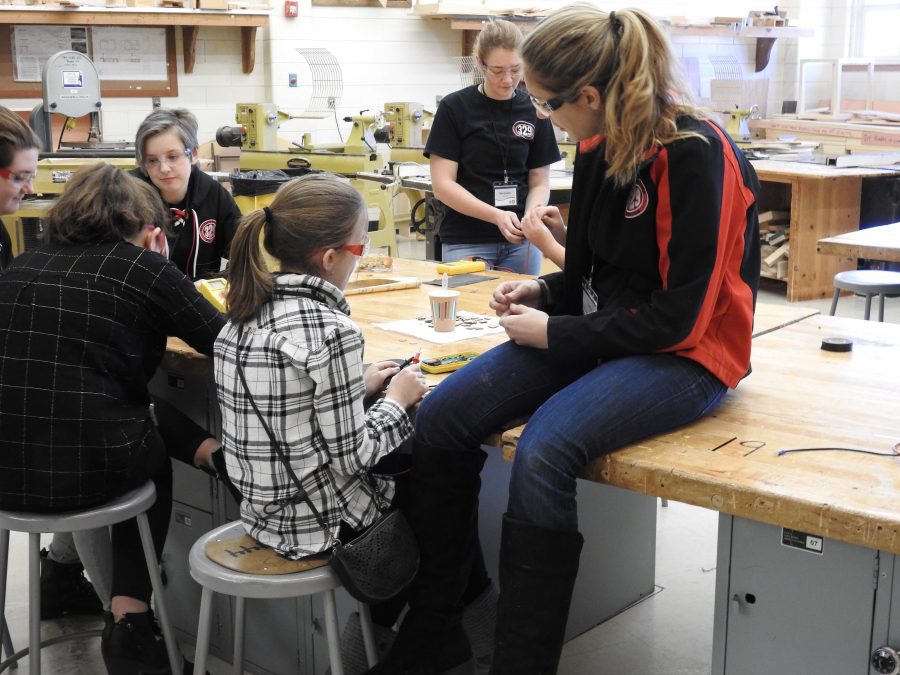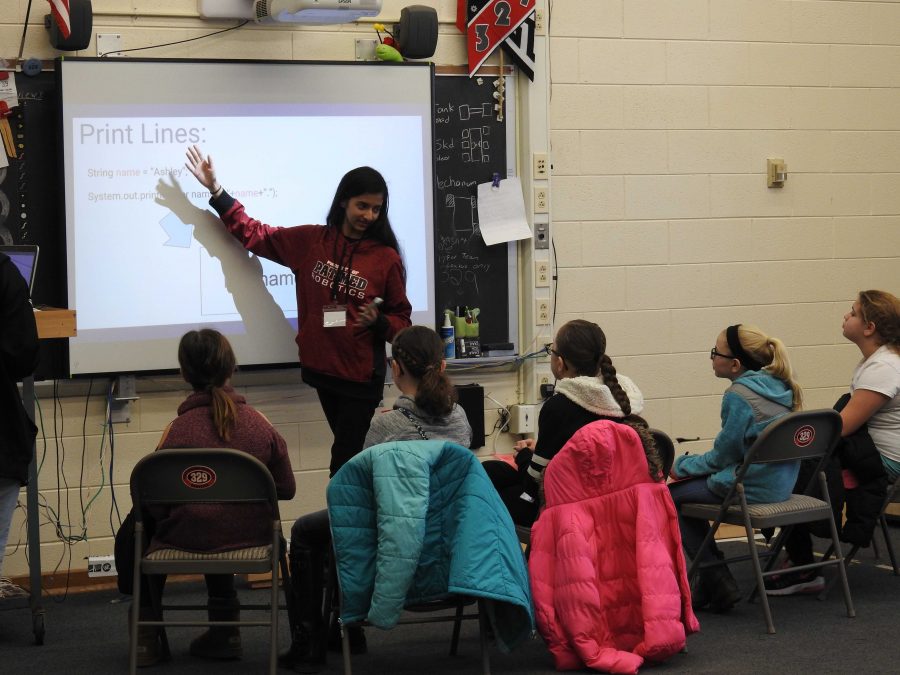Bridging the Gender Gap
Women all over the country have recently made headlines standing up for the disturbing lack of female presence in the STEM field, both in school and in the workforce.
Photo by FRC Team 329 parent mentor, Joseph Paradiso
Team leader Emily Berkemeyer showing a participant a circuit board and teaching fundamentals of electricity.
Imagine this.
It is your first day of college. You are away from home, have no idea who anyone is, and are in a major that is so hard the average GPA for graduating students with your degree is nearly a 2.8 . You walk into your first class and out of 100 students, only 1 is your gender.
Now that sounds inviting, right?
Unfortunately, this is the painful reality for women entering STEM fields in college. The phenomenon has been occurring for a while and although attention has been brought to the issue in recent decades, women are still severely underrepresented in STEM.
The Issue
Throughout history, there is no question as to why women have had little representation in these fields.
With lack of equal education opportunities and sexism, occupations like chemical engineering and quantum physics really were not plausible for females. As time continued, however, women became STEM innovators and leaders, earlier than you probably think.
Many women were the brains behind internationally recognized projects and discoveries that went on to win Nobel Prizes. What people do not realize, is that often their male lab partners are credited for their discoveries and it is those males that we learn about in class. A great example is Rosalind Franklin; Franklin is the biophysicists whose research and understanding of molecular biology developed our modern understanding of DNA and RNA structures. This research has become vital to innovations in today’s medicine; however, Franklin did not win a Nobel Prize or gain much recognition for this until 25 years after the fact. James Watson and Francis Crick (sounds familiar, right?) were given recognition for discovering the structure of DNA. In fact, the double helix diagram of DNA is commonly known as the “Watson and Crick Model”. Franklin received little, if any, recognition for her research which the two men used to create the diagram. The two men did not even cite her research which was essential to their work.
It becomes difficult to inspire the next generation of female STEM leaders when female discoveries aren’t publicized, and when students only learn about Watson and Crick. In fact, it makes it almost impossible. At the most impressionable of ages girls are not exposed to female innovators. This discourages them from entering STEM fields and no matter how interested they may be, without a role model or someone to aspire to be, entering the field falsely appears to be an unattainable dream.
The Solution
According to The US Census Bureau, women make up 27% of computer professionals and only 13% of engineers. Many STEM related organizations have recognized this disparity and are striving to bridge the gender gap that exists today. Organizations like FIRST Robotics encourage high school robotics teams to get out and spread STEM at the primary and secondary level, especially to the female population.
Our own high school’s robotics team(FRC Team 329) has made it a key goal of theirs to encourage women in science and engineering. Here is some insight as to what our female demographics and accomplishments have entailed over the past 5 years:
❖ Females make up only about 15% of our team on average, however, every year females tend to take up almost 50% of team leadership roles. We may have less girls than boys on our team, but almost all of those few females show high level of intellect, dedication, and leadership.
❖ In 2015, 4/6 “essential positions” on our team were held by females and at competition, our pit had more girls than boys.
❖ The highest and only individual honor a student can earn is the Dean’s List Award. Of our 4 Dean’s Lists Winners, 3 of them were female.
❖ Our female participants have moved on to nationally and internationally recognized universities to study engineering and computer science such as Stony Brook, RIT, RPI, and even Stanford.
❖ Most of our award winning programs were created by females or had females playing a key role in its development including;
- The Water For Haiti Project
- The Junior Engineering Program
- Girls Who Can Computer Programming Summer Course
- Girls STEM Seminar
- The Road to Cuba Initiative
- District Junior FLL and FLL Teams
Most recently, our female team leaders created The Girls STEM Seminar where all 6th through 8th grade girls in Patchogue- Medford were invited to spend a day in our robotics lab and learn basic mechanics, computer programming, 3D modeling, and electrical principles. The entire seminar was led by college and high school robotics participants who taught nearly 100 middle school girls in the span of 3 weeks. The girls who attended this seminar were already interested in the STEM fields, which is why they signed up to attend. Of these “STEM Interested” girls, only 37% said that they wanted to go into a STEM related field. For a pool of girls who consider themselves math and science oriented, this number is shockingly low and unfortunately, is more like to decrease than increase as these girls move on to high school.With projects such as the Girls Seminar, it is our hope that more girls in our district will feel inspired to pursue the STEM fields through joining related clubs and courses. The idea is simple, to lead by example. If you show elementary and middle school girls that there are females in high school and college who are successful in and essential to their robotics team, it makes that “unattainable dream” a reality.
The topic of the Gender Gap in STEM Fields has been high profile and is increasingly getting more coverage; however, according to the US Census Bureau, “The most recent decades show less growth in STEM employment among younger women. Most of the growth in women’s share of STEM employment among those under the age of 40 occurred between 1970 and 1990.” So what are we doing wrong? With STEM opportunities in the work field increasing, why aren’t females filling them? It appears that more work is being done to get women in STEM, but maybe more isn’t enough. We need to make it known to all girls that they can make scientific discoveries. They can problem solve. They can innovate. They can be engineers. By having a limited number of females in the STEM world, we are not only limiting our technological growth but our growth as a society. It is time to explore what more we all can do to get women out in the STEM fields. It is time to finally bridge the gender gap .







